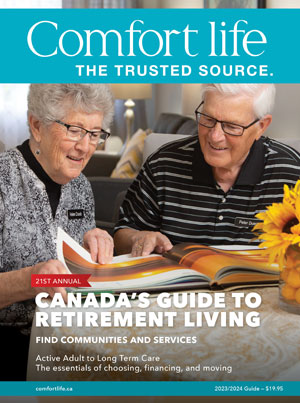What to know about this topic:
- Seeing an opportunity to declutter
- Separate clothing into categories
- Bring your old favourites
- How much clothing should you bring?
- Washable clothes
- Applying nametags to clothing
- Personal care items, toiletries and footwear
- Out-of-season clothing
- Your valuable jewelry
- Make sure to treat yourself!
Cleaning out your closets can be a big job so take your time and enlist the help —and advice—of family and friends. Plan to take regular breaks too. Depending on how much clothing you have—and how much you've stuffed into the back of your closet—this could take a while!
Seeing an opportunity to declutter
We all keep more clothing than we need so use this move as a motivator for downsizing and getting rid of all those things you never wear. You'll be happy you did; you don't want to bring clothes or accessories that may be out of style, may not fit or may even be lacking buttons…to your new home.
Separate clothing into categories
Start in a clean room with plenty of space for three piles—keep, give away and discard. If you aren't sure about a piece of clothing or an accessory, try it on and ask a friend or family member for a second opinion. If you don't love it and it doesn't make you feel good right away, get rid of it! The clothes you don't bring can be donated to a worthy cause such as a charity or consignment store or given to other residents at your new community. If you don't have time or energy to take care of this, ask a friend or family member to help out.
Bring your old favourites
You want to be comfortable so definitely bring your favourite pieces that you wear all the time—pjs, robe, dresses, skirts, shorts and pants—and don't forget accessories like ties, belts and scarves. They are generally small and take up less room but take only those you really love and wear most often. Remember that your new residence may have less wardrobe space than your current home so be disciplined with these choices.
How much clothing should you bring?
It's a good idea to have enough clothing (including sleepwear, underclothes, accessories, coat and hat) to last you for two full weeks. That way when it's laundry day (which usually happens once a week) you will have a full week's worth of clothes on hand and you won't be waiting to get something out of the laundry.
Washable clothes
One of the great benefits about moving to a retirement community is that you don't have to wash your clothes anymore! That means that any clothing you bring needs to be machine washable and must not shrink or fade in high washer and dryer temperatures. Don't bring items that need to be hand-washed unless you are prepared to wash them out yourself. Remember that your living space is limited and there may not be enough space to hang them up. If some items need to be dry-cleaned check to see if the retirement home provides this service or make sure a friend or family member can take care of it for you.
Applying nametags to clothing
Having your laundry done for you also means that you'll need to sew nametags into your clothes to be sure they don't get lost in wash. Include your full name and your room number on every piece of clothing or washable accessory such as a scarf or cloth belt. If you'd rather not sew nametags on everything just write the information down on an inconspicuous part of the item using a permanent marker instead. This could be a good project for a grandchild or other family member.
Personal care items, toiletries and footwear
Don't forget to bring all the personal care items you'll need from your bedroom dresser, bathroom cabinet and hall closet.
These may include:
|
|
Out-of-season clothing
Closet space is often limited so there may be no room in your new place to keep your out-of-season clothes, shoes or boots. Put them in storage. Clearly label the containers (consider transparent ones) so you know exactly what you're retrieving next winter or spring. You don't want to buy something next season that you already own!
Your valuable jewelry
It's always safest to bring costume jewelry rather than your more valuable pieces but you may still want to bring some of your expensive or heriloom items because they have sentimental value. Consider leaving most of this jewelry with a trusted family member or friend and also ask the retirement community what safeguards they have in place for such valuables. You may be able to purchase a small safe to keep in your room or you may want to keep some small items in a safety deposit box at your bank.
Make sure you have a plan for your jewelry before you move into the retirement community. Do not bring it to your suite and leave it in your dresser until you decide what to do.
Make sure to treat yourself!
Now that you've decided what to bring and gotten rid of all the things you never wear, consider buying a new outfit to celebrate this new chapter of your life.
And be sure to bring a friend to the store—it's good to get a second opinion and it's a lot more fun!
~ Kathy Barthel




